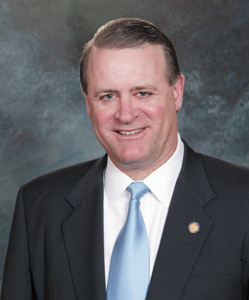STRAIGHT FROM THE SENATE
 THOUGHTS ON REDISTRICTING
THOUGHTS ON REDISTRICTING
STATEHOUSE – There is significant interest in the preparation and actual crafting of Indiana’s congressional and state legislative districts that, by law, must be redrawn and approved by the end of the 2011 session.
Some have suggested an independent commission should be created to handle this task. While this is a concept that should be thoroughly explored, and may in fact be the best way to manage redistricting for future generations of Hoosiers, the fact remains that the Indiana Constitution requires the state legislature to handle this task.
Clearly, our Indiana Constitution would have to be amended to allow a commission to take over, and under the best case scenario, an amendment could not legally come before the voters for their consideration before the 2012 election. That is too late to affect the upcoming redistricting that, again, must be approved by April of 2011.
It is important, therefore, to begin to communicate with the public about what the rules and goals of the redistricting process should be. Below are my thoughts, as the President Pro Tem of the Indiana Senate, as to how that process should be approached.
1. The protection of the representation and interests of the people of the state of Indiana is of paramount importance in the redistricting of Indiana’s congressional and state legislative districts. As such, no district should be drawn with the goal of improperly favoring any person or political party.
2. The principal of equal population figures for each House and Senate seat should be followed as closely as practicable. Deviations from this definitive rule should be avoided wherever possible. Under the last redistricting in 2001, the population deviations for Indiana House seats were less than 2 percent and for the Indiana Senate, less than 4 percent. A crucial goal of the 2011 redistricting plan should be to reduce these numbers even further. It should be noted that congressional seats are provided even less latitude in population deviation due to past rulings of the U.S. Supreme Court.
3. Criteria other than overall population of the district that should be utilized must include, but not be limited to, the following :
a. Preserving traditional neighborhoods;
b. Preserving local communities of interest based upon cultural, ethnic, geographic, and socio-economic similarities;
c. Protecting minority voting rights consistent with the U.S. Constitution and the Indiana Constitution, as interpreted by the U.S. and Indiana Supreme Courts;
d. Keeping districts compact, particularly where population density is greatest, to avoid dividing communities of interest;
e. Avoiding oddly shaped districts; however, rational and logical deviations may occur where an effort is made to follow a political subdivision’s boundaries or to follow natural geographic boundaries;
f. Taking county lines into consideration, but those boundary lines should not be sacrosanct. Crossing county lines can make sense to preserve economic, social and geographic populations and to achieve the requisite population balance for the district. However, the number of counties utilized to comprise a district should be kept to a minimum, and the counties within such district should be as contiguous as possible; and
g. Maintaining, whenever practicable, voting precincts within a single legislative district to prevent division of communities of interest, to prevent voter confusion, and to minimize administrative costs of elections.
Senate leadership will work closely with its counterparts in the House to ensure that the above criteria are utilized in the redistricting of the congressional and state legislative seats in 2011. Our goal will be to have the most open, transparent redistricting process ever conducted in this State. The technological advances of today should allow for unprecedented public input into the redistricting effort, including statewide hearings and opportunities for citizens and various organizations to submit their own suggestions and maps to the legislature for consideration.
While the final district maps cannot be crafted and approved until the 2010 census data is provided to Indiana by the Federal government (likely available by early March 2011), the preliminary effort is already beginning. I look forward to working with all interested parties over the next 20 months as we strive to create the fairest and most representative congressional and state legislative districts possible.
Sen. David Long (R-Fort Wayne) is President Pro Tem of the Indiana Senate. He serves District 16, which includes portions of Fort Wayne.
- Celebrating 20 Years Of Community At The Stand - April 12, 2024
- First Positive Case Of Chronic Wasting Disease In Indiana - April 12, 2024
- Southwest Allen County Schools Embark On Major Tree Plantings - April 12, 2024


